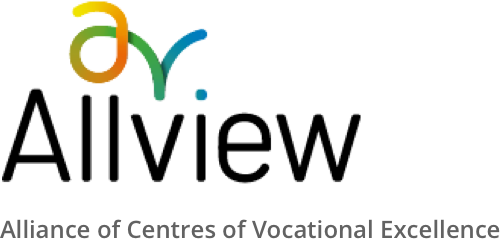The report ‘Study of the pathways to HE’ assessed knowledge gaps in Circular Economy and Ambient Assisted Living and identified and how modern Industry 4.0 technologies support closing these shortages
ALLVIEW partners have released a new report to show the results of task T2.5 “Study of the pathways to HE”, which is the last activity of WP2 “Blended learning library for the W&F sector”. The partners from ULUB (University of Ljubljana), reviewed the learning objectives of Vocational (VET) and Higher (HE) education in order to develop a model for transferring learning contents within both levels of education.
Why this report?
Due to rapid technological development and increasing digitalization, the business environment is changing rapidly, which also has a strong impact on the concept of education. The COVID-19 pandemic has also made a significant contribution to the even faster digital transformation of the business and educational environment.On the other hand, the European furniture industry faces a variety of economic, regulatory, and environmental challenges. To thoroughly prepare future generations for current topics such as Circular Economy, Industry 4.0 and Ambient Assisted Living, we need to provide appropriate educational content and, in the future, ensure its integration at all levels of education also in the wood and furniture sector. Thus, ALLVIEW project aims to ease on this process.
Knowledge Gap Matrix
Partners assessed VET and HE knowledge gaps in Circular Economy and Ambient Assisted Living and identified how to fill these gaps and how modern Industry 4.0 technologies can help us to do so. Moreover, a classification parameter of educational programs at both VET and HE as well as a comparison between projects was done to find out the possible learning contents and concepts already developed. The goal was to develop a model showing the current and expected level of knowledge and gaps between levels of education in the wood and furniture sector.
For this purpose, ULUB set a series of tasks to draw important conclusions. Firstly, they conducted a knowledge gap analysis which normally occurs when there are significant discrepancies between what the education system provides and what practice/economy/business requires in terms of expertise, skills, and know-how from educated/qualified employees. This task allows them to find out about the knowledge gap along the whole vertical from VET to HE and between what the educational systems offer and what the practice/business demands, focusing on the following three areas: Circular Economy (CE), Industry 4.0 (I4.0) and Ambient Assisted Living (AAL).
It is very important to align learning content, concepts and curricula along the entire vertical from VET to HE to ensure basic knowledge at the lower levels and advanced knowledge at the higher levels of the education systems. To obtain all these data, ULUB carried out different activities such as surveying and interviewing teachers from VET and HE in the field of wood and furniture education, companies, experts in specific fields (CE, I4.0 and AAL) as well as collecting data from other projects.
Secondly, partners analysed the obtained data using a knowledge gap matrix and developed a model/strategy to bridge the gaps and facilitate the transition from VET to HE. In the report, ULUB try to propose ways to fill the identified knowledge gaps. In the model/strategy, vertical transitions were addressed very carefully: what should be achieved at a single educational level (EQF 4, 5, 6, etc.) and how can content/concepts be transferred from a lower educational level to a higher level.
The full report is available here.

